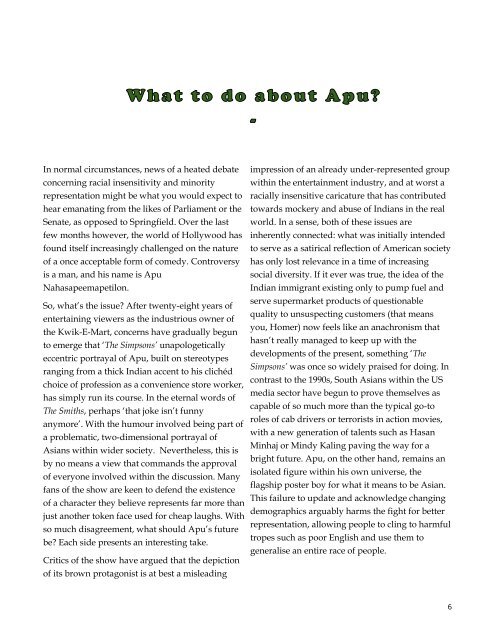Issue 3
You also want an ePaper? Increase the reach of your titles
YUMPU automatically turns print PDFs into web optimized ePapers that Google loves.
In normal circumstances, news of a heated debate<br />
concerning racial insensitivity and minority<br />
representation might be what you would expect to<br />
hear emanating from the likes of Parliament or the<br />
Senate, as opposed to Springfield. Over the last<br />
few months however, the world of Hollywood has<br />
found itself increasingly challenged on the nature<br />
of a once acceptable form of comedy. Controversy<br />
is a man, and his name is Apu<br />
Nahasapeemapetilon.<br />
So, what’s the issue? After twenty-eight years of<br />
entertaining viewers as the industrious owner of<br />
the Kwik-E-Mart, concerns have gradually begun<br />
to emerge that ‘The Simpsons’ unapologetically<br />
eccentric portrayal of Apu, built on stereotypes<br />
ranging from a thick Indian accent to his clichéd<br />
choice of profession as a convenience store worker,<br />
has simply run its course. In the eternal words of<br />
The Smiths, perhaps ‘that joke isn’t funny<br />
anymore’. With the humour involved being part of<br />
a problematic, two-dimensional portrayal of<br />
Asians within wider society. Nevertheless, this is<br />
by no means a view that commands the approval<br />
of everyone involved within the discussion. Many<br />
fans of the show are keen to defend the existence<br />
of a character they believe represents far more than<br />
just another token face used for cheap laughs. With<br />
so much disagreement, what should Apu’s future<br />
be? Each side presents an interesting take.<br />
Critics of the show have argued that the depiction<br />
of its brown protagonist is at best a misleading<br />
impression of an already under-represented group<br />
within the entertainment industry, and at worst a<br />
racially insensitive caricature that has contributed<br />
towards mockery and abuse of Indians in the real<br />
world. In a sense, both of these issues are<br />
inherently connected: what was initially intended<br />
to serve as a satirical reflection of American society<br />
has only lost relevance in a time of increasing<br />
social diversity. If it ever was true, the idea of the<br />
Indian immigrant existing only to pump fuel and<br />
serve supermarket products of questionable<br />
quality to unsuspecting customers (that means<br />
you, Homer) now feels like an anachronism that<br />
hasn’t really managed to keep up with the<br />
developments of the present, something ‘The<br />
Simpsons’ was once so widely praised for doing. In<br />
contrast to the 1990s, South Asians within the US<br />
media sector have begun to prove themselves as<br />
capable of so much more than the typical go-to<br />
roles of cab drivers or terrorists in action movies,<br />
with a new generation of talents such as Hasan<br />
Minhaj or Mindy Kaling paving the way for a<br />
bright future. Apu, on the other hand, remains an<br />
isolated figure within his own universe, the<br />
flagship poster boy for what it means to be Asian.<br />
This failure to update and acknowledge changing<br />
demographics arguably harms the fight for better<br />
representation, allowing people to cling to harmful<br />
tropes such as poor English and use them to<br />
generalise an entire race of people.<br />
6



